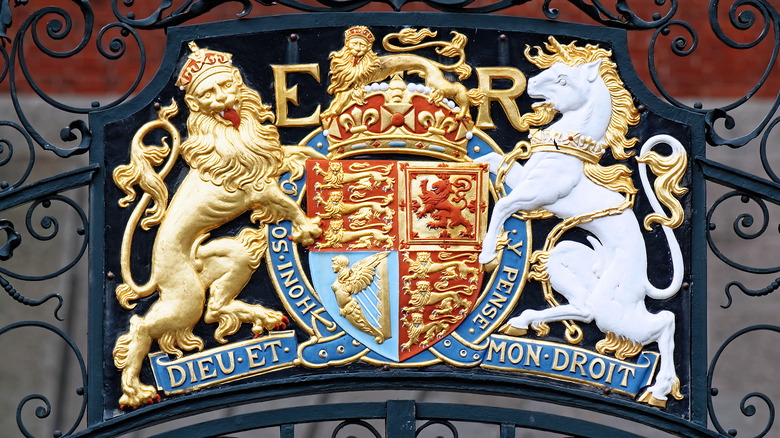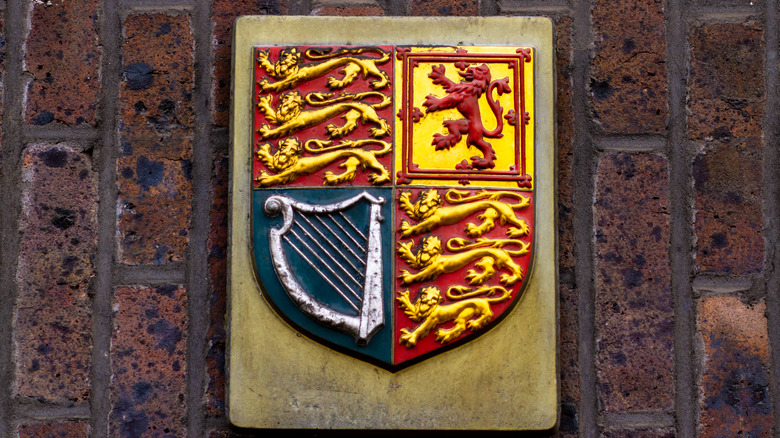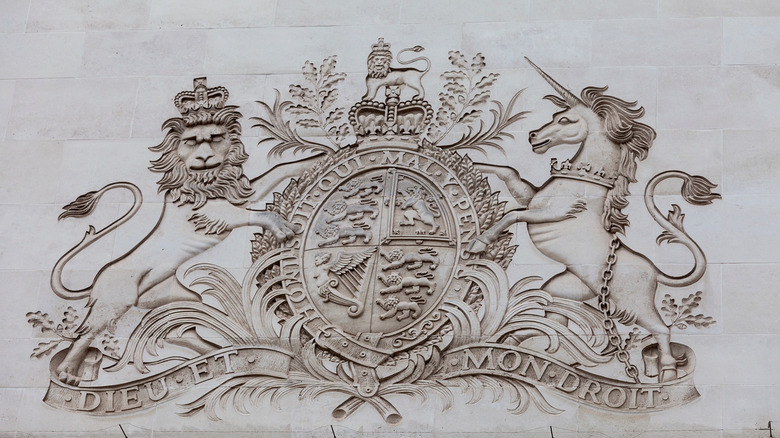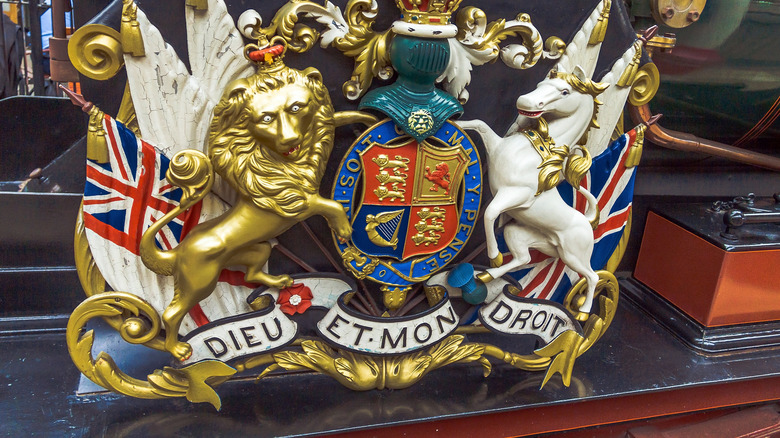The British Royal Coat Of Arms Explained
Since the Middle Ages, the aristocrats and noble houses of Europe have maintained a unique symbol, called the coat of arms, to represent who and what they are. Originally, knights would paint a unique pattern on their shields, to remain identifiable in their heavy armor (per Britannica). Soon these patterns became hereditary, passed from father to son, sometimes changing to accommodate new titles, marriages, or other details. When shields became obsolete, the coat of arms became a kind of personal logo. Heraldry — the art of the coat of arms — grew more and more complex with the centuries, with mottoes and symbolic animals added to the simple shield; actual courts, called colleges of arms, to adjudicate legal disputes; and arms for cities and countries as well as people.
Seen above is one of the most recognizable coats of arms in the world: the arms of the House of Windsor, the ruling family of the United Kingdom. The inscription "E.R." stands for "Elizabeth Regina," or Queen Elizabeth, under whose reign this particular "edition" of the coat of arms was made. But what are the other elements: the lions, the six leopards, the unicorn, the harp, and the French words?
The Escutcheon
The heart of any coat of arms is its escutcheon — or shield. In this case, the shield is divided into four parts. This, as the Heraldry Society explains, is called quartering. Typically, a coat of arms will be quartered to show the marriage of two arms-bearing families. In this case, however, the families are the constituent countries of the United Kingdom. The dominant country, England, gets two quarters (including the "honorable quarter," top left). England is here symbolized by three leopards. Yes, they look like lions: heraldic tradition calls lions "leopards" when displayed "passant guardant," or walking while looking at the viewer, per the Heraldry Society.
The lion in the top right is Scotland, and the harp represents Ireland. And Wales? As the Royal Family's website points out, the principality of Wales had long been incorporated into the Kingdom of England at the time of the Acts of Union, which brought England, Scotland, and Ireland into one state.
The supporters
Flanking the escutcheon are two animals, who seem to be holding the shield up. These are called — logically — supporters. On our left, a lion; on our right, a unicorn, with a chain around his neck.
This pairing was instituted in 1603, when the English parliament invited James VI of Scotland to become James I of England, succeeding the childless Elizabeth I. The unicorn is an old symbol of Scotland; the lion has likely represented the English royalty since the 12th century, per the Heraldry Society, so a lion and a unicorn holding up the royal arms together symbolized the union of the two countries under one monarchy. The chain around the unicorn's neck hints that this relationship is not one of equals, however. Anglo-Scottish relations have been turbulent over the past thousand years, as viewers of Braveheart may have twigged.
An alternate story told by the National Trust for Scotland says the gold chains may be there to show that only Scottish kings were strong enough to capture the infamously hard-to-tame mythical creature. Nevertheless, as long as the monarch of England is also the monarch of Scotland, the rearing unicorn will go on holding its shield.
The mottoes
The coat of arms features two mottoes. One sits under the supporters' feet, on a scroll: "Dieu et mon droit," or "God and my right" in French. It's a fierce affirmation of the monarch's right to rule, which none but God may question. According to the Sun, Richard I, called the Lionheart, first used this phrase during his wars with the King of France. Richard's first language was French, which is why the phrase is not in English. Henry V made the motto official during his own wars against France.
Around the shield is another motto, this time on what looks like a belt: "Honi soit qui mal y pense," or "Shame on him who thinks ill of it." This is the motto of the Most Noble Order of the Garter, the highest honor the British monarch can bestow. Founded in 1348, it still constitutes a knighthood, with 25 members at any given time beside the reigning monarch and the Prince of Wales. Legend holds that Edward III was dancing with the Countess of Salisbury at a party when one of her garters slipped off her thigh and fell to the ground. People began to laugh at the embarrassed woman. But the gallant king picked up the garter and tied it around his own thigh, silencing the crowd by crying out, "Shame on him who thinks ill of it!" (via Britannica). The belt it's written on in the coat of arms isn't a belt at all: it's the lady's fallen underwear.



